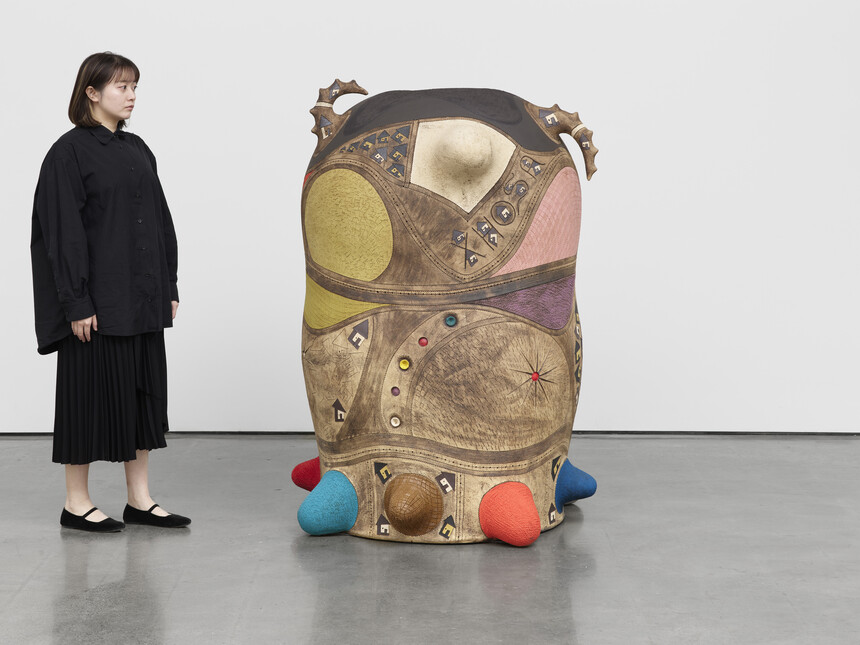
21 Dec Umthonyama
Source Credit: Content and images from Wall Street International Magazine by . Read the original article - https://www.meer.com/en/86367-umthonyama

David Kordansky Gallery is pleased to announce Umthonyama, a solo exhibition of new ceramic sculpture
by Simphiwe Mbunyuza. The exhibition is on view in New York at 520 W. 20th St., from January 16 through February 22, 2025. An opening reception will be held on Thursday, January 16 from 6 to 8 PM.
Mbunyuza’s work stems from a personal and spiritual exploration of long-performed ritual and iconography
associated with the Xhosa people of the Eastern Cape Province of South Africa. Throughout his practice, the
artist has developed a unique approach to his materials, in which he’s able to achieve uncommon textures and
glazes that highlight his grasp of both the material itself and the processes and temperatures in which clay is
fired. Each sculpture incorporates distinct markings in the shapes of houses, animals, garments, and ridged
or stippled patterns, arranged in large swaths and demarcated by contrasting colors and impressed linework.
The exhibition takes its name from a term used to define the rectangular section within a family’s livestock
enclosure where familial rituals take place. By designating this space as a kind of divine site, it maintains the
spiritual potency, so that reinterpretations of the physical space may retain some of that sanctity. The physical
and intangible aspects of Umthonyama work together to help participants attune to their ancestors. Family
members may fast, separate from their partners, or alter other aspects of their daily life prior to the performance
of the ritual in order to shift their focus entirely on accessing the deepest wells of their spirituality.
Throughout the exhibition, figurative forms act as conduits to familial ancestors. This selection of new works
primarily focuses on two different scales; the larger sculptures, measuring roughly five feet tall, represent relatives who would have crossed over generations ago and whose names are often invoked throughout religious
ceremonies. The smaller works on view, however, offer abstracted visualizations of the less developed or younger
spirits inhabited by living relatives, including Mbunyuza and his immediate family. The placement of the works
within the exhibition and the relationship of the various forms in relation to one another offer a tangible access
point to an otherwise exclusive, deeply spiritual, world.
Smaller works, like Igwele (2024) with its open top and horn-like handle, also call to mind other elements
present in the umthonyama, such as pots used for the fermenting and drinking of traditional beer and wide
mouthed bowls that hold the remains of sacrificial animals and plant matter. The flattened lip lining the edge
of Igwele’s rim recalls traditional skirts and dress of Xhosa women. In this way, Mbunyuza’s works are inseparable from the customs, people, and place he knows as home. The disparate visual imagery comes together in
surprising configurations, marrying color and texture to transform raw material into striking sculptural works.
Animals play a vital role in these ceremonies, but also in Xhosa society more broadly. Horn-like appendages are
a common feature throughout the exhibition, whether they are affixed to the vessels to give the appearance of
a handle, curled up to mimic an animal tail, or—in the case of Ndlebentle’zombini (2024)—as an opposing
set of ears placed near the top, or head, of the figure. This work is one of a few pieces that incorporate language
onto the surface of the form; in this case the word “Xhosa” in capital letters, adorned with little drawings of blue
and white houses. The vibrant tones Mbunyuza is able to achieve are contrasted by large stretches of dirt-like
browns that appear almost smeared on by the artist’s hand, alluding to the earth from which the material came
and the exterior landscapes in which the rituals that inspired this group of works take place.
At the heart of Mbunyuza’s project is an intention to honor and amplify the people and places he holds dear.
The artist channels an intuition-led process to guide him through every stage of making. Work is completed in
response to impulses whenever they arise so that, in a way, the circumstances of each piece’s creation carry
a divine quality in and of themselves. The physical manipulation of clay—paired with subconscious or overt
visions and ideas—moves the artist to create unique works rich with color and deeply rooted in cultural meaning.
Simphiwe Mbunyuza (b. 1989, Butterworth, Eastern Cape, South Africa) recently completed a long-term
artist residency at Archie Bray Foundation for the Ceramic Arts in Helena, Montana. Recent group exhibitions include ArtNow, Oklahoma Contemporary, Oklahoma City (2021); Small Objects, A.I.R. Vallauris, France
(2017); Franschhoek Annual Festival, Art in the Yard Gallery, Franschhoek, South Africa (2016), among others.
Mbunyuza lives and works in Butterworth, East Cape, South Africa.
Source Credit: Content and images from Wall Street International Magazine by . Read the original article - https://www.meer.com/en/86367-umthonyama

